Anyone can make awesome doodles with just a pen and a bit of imagination! Circles, wavy lines, and simple flowers are perfect places to start, and even sunbursts or sweet treat designs look cool with a few basic shapes. Try cross hatching for texture, experiment with continuous lines, and fill space with silly patterns or desserts—donuts never judge. Even doodling everyday objects or animals can turn boring notes into masterpieces. Curious? There’s plenty more easy ideas ahead!
Key Takeaways
- Break down everyday objects into basic shapes like circles, squares, and triangles for easy doodling.
- Practice simple flowers, sun motifs, and moon doodles using overlapping circles and curved lines.
- Draw cute animal faces and expressive emoji doodles with bold features and playful lines.
- Use techniques like cross hatching, continuous line art, and nested shapes to add patterns and texture.
- Sweet treats, hearts, and nature-inspired designs offer quick, whimsical doodles perfect for any skill level.
Doodling Circles
Circles—those simple, swirling shapes—might seem basic, but don’t let them fool you. In the world of doodle drawing, circles are like the secret agents of creativity.
Drawing big, flowing circles using your whole arm isn’t just fun—it’s a mini workout! Try out different sizes, from giant orbs to tiny pebbles, tossing them all over your page for a wild, unexpected look.
Want to kick things up a notch? Grab a 0.5mm Staedtler pigment liner for crisp, clean lines and fill each circle with patterns, zigzags, or even mini-circles. The result? Your page goes from boring to absolutely bursting with energy.
Every circular doodle is a springboard for bigger, bolder designs—circles really are more exciting than they look!
Cross Hatching a Random Pattern
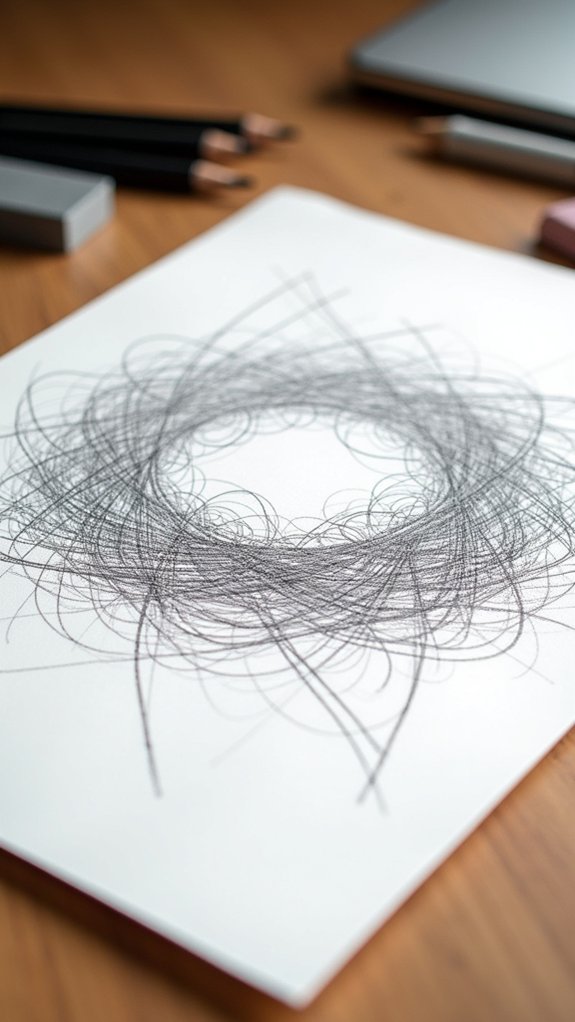
After circling around with bursts of swirling energy, now it’s time to let the pen get a little edgy—literally!
Cross hatching is where lines take on a life of their own, crossing and crisscrossing like a tiny dance battle on your paper. To start, draw parallel lines in one direction, keeping things cool and simple.
Then, layer on more lines in a new direction—boom, instant shading and depth. If you want your doodle to feel random and exciting, switch up how close your lines are or how thick they get.
Grab a fine-tipped pen, like a 0.5mm Staedtler, and go wild. Experiment with wild angles and intersections. Each pattern becomes unique, adding tons of texture and serious visual interest.
Continuous Line Art
Jump into continuous line art, where a single, never-ending line brings doodles to life like a one-line rollercoaster ride across the page.
With continuous line art, there’s no lifting your pencil—just one smooth, brave motion forming shapes and figures. It’s like playing a game of “don’t touch the pencil down!” while letting your hand and eyes work together in perfect, if slightly wobbly, harmony.
The cool part? This technique doesn’t care about tiny, fussy details; it captures the heart of what you’re drawing with bold, fluid lines.
Continuous line art helps artists improve hand-eye coordination and fine motor skills, all while producing whimsical designs. Best of all, anyone—from total beginner to pro—can doodle with this simple, versatile style.
Drawing Simple Flowers
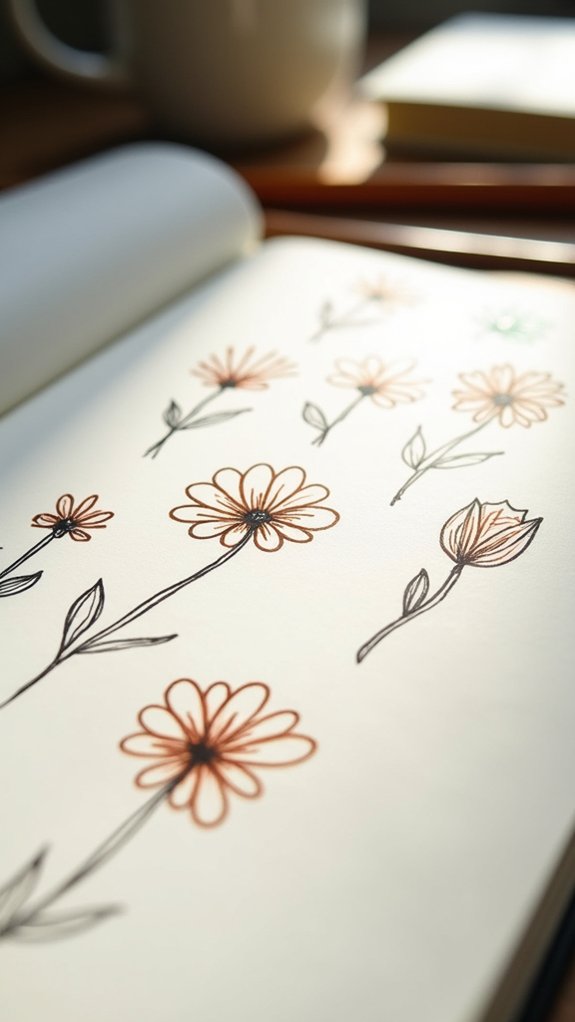
Drawing simple flowers is a quick way to fill your sketchbook with colorful, happy doodles, and the best part is anyone can do it—no green thumb required.
Start with a circle, sketch some small petals, then add more layers with bigger petals to make your flower pop off the page like it just got good news.
If you want to give your blooms even more personality, play around with drops of detail inside each petal and try stems or leaves—suddenly, your simple flower sketch looks like a whole garden party!
Quick Flower Sketch Techniques
There’s something super satisfying about seeing a simple flower take shape on paper in just a few steps—almost like a magic trick, but way easier!
The process starts with drawing a small circle for the flower’s center. Next, ovals or teardrop shapes are added around it as petals, with each petal slightly overlapping its neighbor, making the flower look fuller and more interesting.
The petals can point in all sorts of angles, so don’t worry about being perfect; the more variety, the more charm! For the leaves, drawing elongated shapes with pointy ends and attaching them to the flower’s base does the trick.
Using a thinner pen for lines or patterns inside petals makes each doodle pop. Practice with daisies, tulips, or invent your own!
Adding Layers for Dimension
Once a basic flower doodle starts to bloom on the page, it might look a little flat, kind of like a pizza before toppings—cheesy, but missing some magic.
That’s where adding layers for dimension kicks things up a notch! Begin with a central circle for the flower’s core, then jazz it up with little circles or swirls inside.
Next, draw 5-6 big petals that slightly overlap—this is like giving your flower its first layer of “petal power.”
Want more wow? Add another set of petals behind the first, this time changing their sizes and shapes to keep things interesting.
Grab a thinner pen to sketch lines or patterns inside each petal, then shade one side for light and shadow. Instant depth!
Sun Motifs in Creative Styles
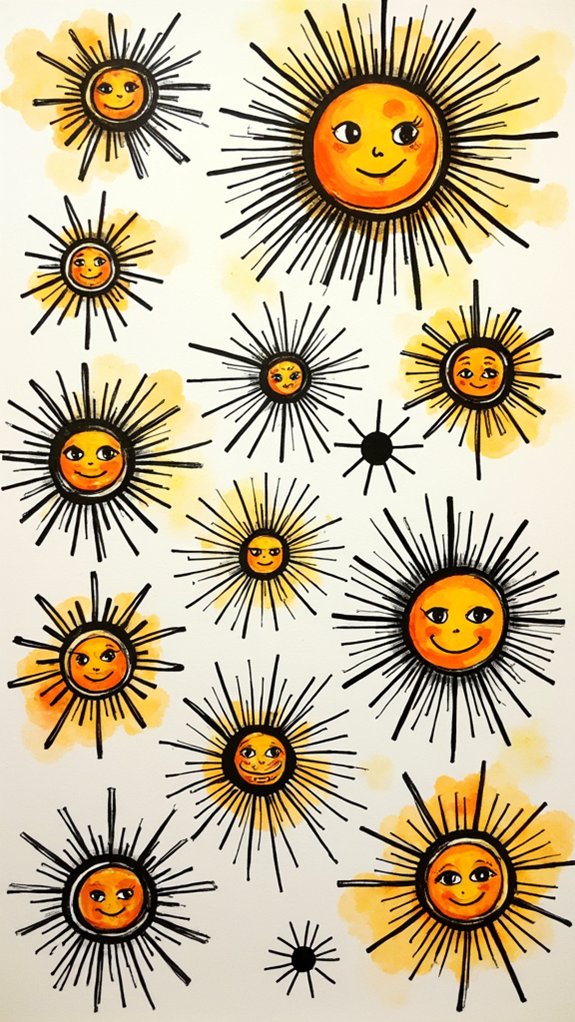
Sun motifs are a blast to experiment with, whether you start with a simple sunburst made of circles and prickly rays or get wild with abstract patterns that make your sun look truly out of this world.
Some artists like to give their suns big goofy grins or even slap on a pair of sunglasses, turning them into playful cartoon characters that almost seem to wink at you.
From neat, orderly rays to swirling lines and bright, bold designs, there’s always a new way to catch that sunny vibe on your page.
Simple Radiant Sunbursts
Many doodlers quickly discover that drawing a radiant sunburst is one of the easiest ways to make their sketchbook pages pop. The secret? Just draw a circle in the center of your page—boom, instant sun!
From there, add elongated triangles shooting outwards for classic rays. Mix it up with rays of different lengths and thicknesses to make your sunburst look more energetic and fun.
Feeling extra? Add wavy lines or curved patterns between rays to capture that warm, sunny feeling—even if it’s raining outside. Doodle in some fluffy clouds or twinkling stars nearby for extra whimsy.
Don’t hold back on colors—bold yellows and vibrant oranges really turn up the cheer. Sunbursts are simple, eye-catching, and totally customizable for any mood!
Abstract Solar Patterns
Creativity gets a major workout with abstract solar patterns—think of them as sun doodles released. These aren’t your typical circles with lines. Instead, abstract solar patterns come alive with overlapping spirals, wavy rays, and bold color combos. Yellow, orange, and red—grab them all!
Layering shapes, like stacking bright circles or swirling lines, adds such amazing depth you’ll want sunglasses just to look at your drawing. Searching for drawing ideas? Try repeating smaller circles or dots around your sun for a hypnotic, rhythmic effect.
Adding clouds or twinkling stars gives your sun some real personality—who says a doodle sun can’t be the life of the party? Abstract solar patterns set your creativity free, making every sun one-of-a-kind and wildly expressive.
Whimsical Cartoon Suns
Nothing brightens up a doodle page quite like a goofy, grinning sun with wild rays shooting out in every direction. Whimsical cartoon suns aren’t just fun to look at—they’re also super easy to draw!
Start with a big, bold circle for the face, then add a giant smile and eyes that practically burst with excitement. Mix up the rays: some can be sharp and zigzaggy, others soft and wavy.
Want to go wild? Throw on some sunglasses, pop a jaunty hat on top, or hide part of the sun behind silly clouds. Use the brightest yellows, oranges, and reds to make the sun shine with happiness.
Just grab a pencil and get creative—anyone can fill a page with cheerful, whimsical cartoon suns!
Expressive Emoji Faces
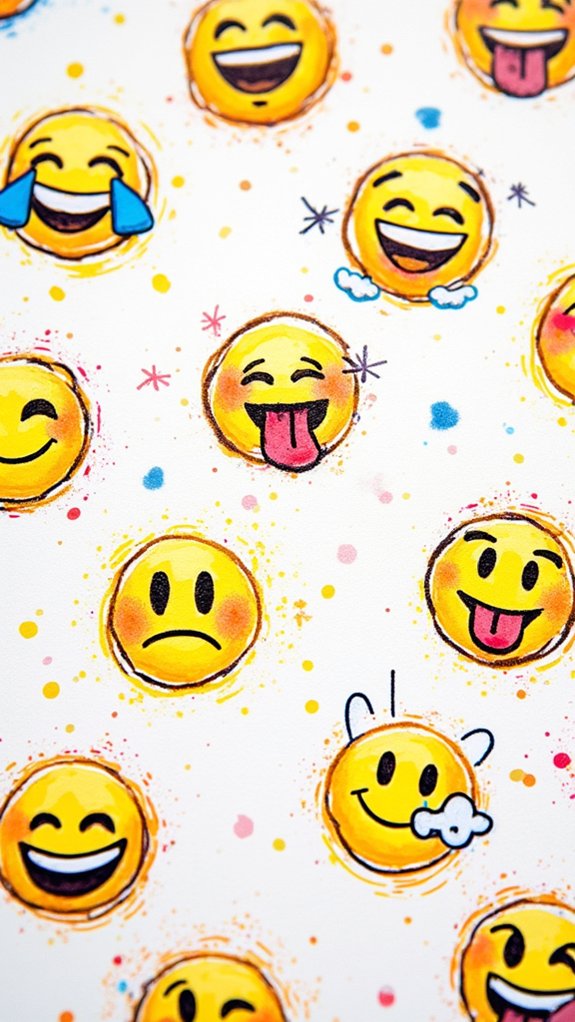
Even if someone has never doodled before, drawing expressive emoji faces is a total game-changer—it’s like opening a secret doorway to quick and hilarious cartoon magic.
All it takes is a simple circle as the base, and suddenly there’s a whole family of faces just waiting to burst into life. Eyes and mouths made from ovals or wiggly lines can shout, laugh, or pout—seriously, you can draw a bunch and each one will look totally different!
People can even add goofy hats, wild glasses, or thick eyebrows to bump up the personality. Bold lines or wild colors? Yes, that’s exactly how emojis go from “meh” to “wow!”
Doodlers get faster and more confident as they practice, so filling a page with emoji faces feels super rewarding.
Heart and Heart-Shaped Doodles
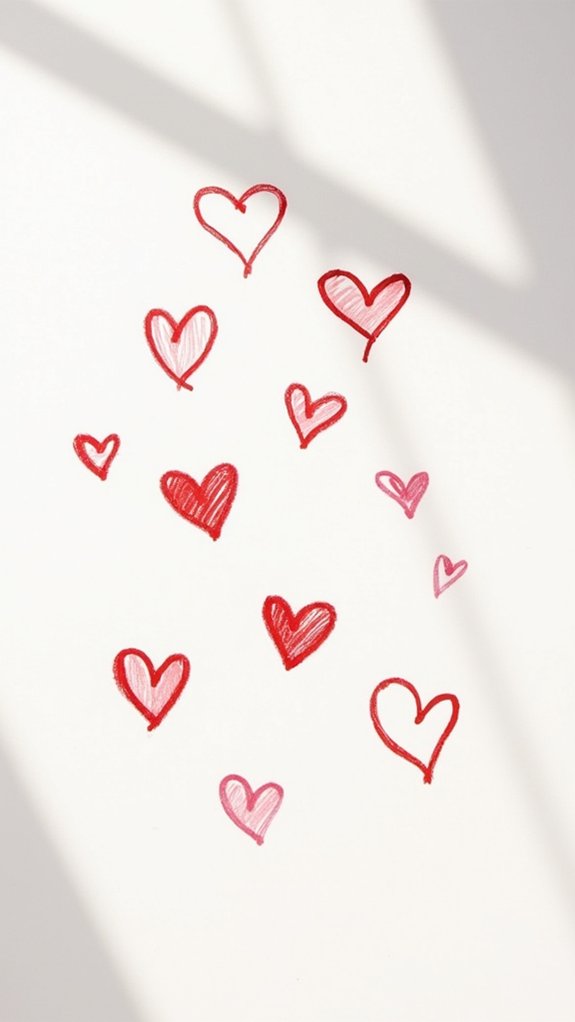
Out of all the doodles out there, heart shapes might win the prize for being the cutest and the fastest to draw—just a couple of curves at the top and a swoop down to a point, and suddenly the page has a heartbeat.
Heart-shaped doodles are super easy—just start with a basic circle for the top, pull it down to a point, and you’re done!
But if you want to level up, mix it up with broken hearts, hearts with wings, or twisting two hearts together. Adding swirls, tiny dots, or even flowers around your heart-shaped doodles piles on the personality.
Try doodling hearts of all sizes and directions for a cool background. Banners, arrows, or fun patterns? Endless possibilities, perfect for making greeting cards unique.
Quick Gestural People Sketches

Hearts are loads of fun, but sometimes a sketchbook just begs for something a little more lively—like people in action! Quick gestural sketches are the answer when you want to draw someone but don’t want to get lost in the details. The best part? It’s all about speed and energy. You start with a few swift lines, maybe a circle for the head, some spaghetti lines for arms, and voila! The focus is on capturing motion and posture, not perfect anatomy.
| Step | Quick Tip |
|---|---|
| Start with a pose | Use sweeping lines for flow |
| Draw basic shapes | Circles & lines simplify the body |
| Add movement | Lines show direction and action |
| Vary line thickness | Adds drama and energy |
| Set a quick timer | 30 seconds is all you need for practice! |
Gestural sketches keep drawing exciting!
Drawing Everyday Objects With Basic Shapes

Turning everyday objects into doodles is all about breaking them down into basic shapes, like circles, squares, or triangles—kind of like building with blocks, but with a pencil.
Suddenly, a boring old mug or a stack of books becomes quick and easy to sketch when you look for the simple parts first and mix them together in your own way.
With a good eye for shapes and a bit of imagination, even a plain spoon could be your next masterpiece—no art degree required!
Starting With Simple Shapes
A blank page isn’t as scary when you realize almost everything can start with a few simple shapes like circles, squares, and triangles.
Take a look around—see that coffee mug? Start with a circle, slap a rectangle on as a handle, and boom, you’ve got a mug.
Want to draw a cat? Circles for the head, triangles for ears, then maybe some ovals tossed in for paws.
By combining and layering these simple shapes, anyone can sketch out bananas, mountains, or even pizza slices.
Change the size and angle of your shapes to make things look real and cool—no one wants a one-dimensional cat!
The more you experiment, the quicker you’ll develop your own doodling style.
Practice makes improvement, so keep doodling!
Observing Objects for Inspiration
Ever wondered how artists can turn a plain old apple or a school backpack into awesome, eye-catching doodles? It all starts with observing objects for inspiration.
Artists don’t just stare blankly at an orange; they break it down into circles and ovals, turning a complicated thing into something totally sketchable! Next time you want to sketch something, look around your room.
Notice how a chair can be seen as rectangles and squares, or how bananas are really just bent cylinders. Practicing sketching common objects from different angles can make your drawings feel more dynamic—and less like lumpy potatoes!
Combining Shapes Creatively
Even if drawing seems tricky at first, breaking things down into basic shapes is like having a secret code to access almost any doodle. Circles, squares, and triangles are the one ticket you need—a circle can become a cup, a square transforms into a present, and, with just a triangle, you’ve got a slice of pizza. Combining shapes takes things to a new level. Try overlapping: stack circles for a snowman or mix a rectangle and triangle for a house. Add lines after you set your shapes, and suddenly, the one scribble turns into real detail.
| Shape | Everyday Object | Fun Twist |
|---|---|---|
| Circle | Cup | Add a mustache handle |
| Rectangle | Book | Draw wavy book pages |
| Triangle | Pizza slice | Pepperoni with tiny ovals |
| Square+Circle | Robot | Give it silly shoes |
Cute Animal Expressions
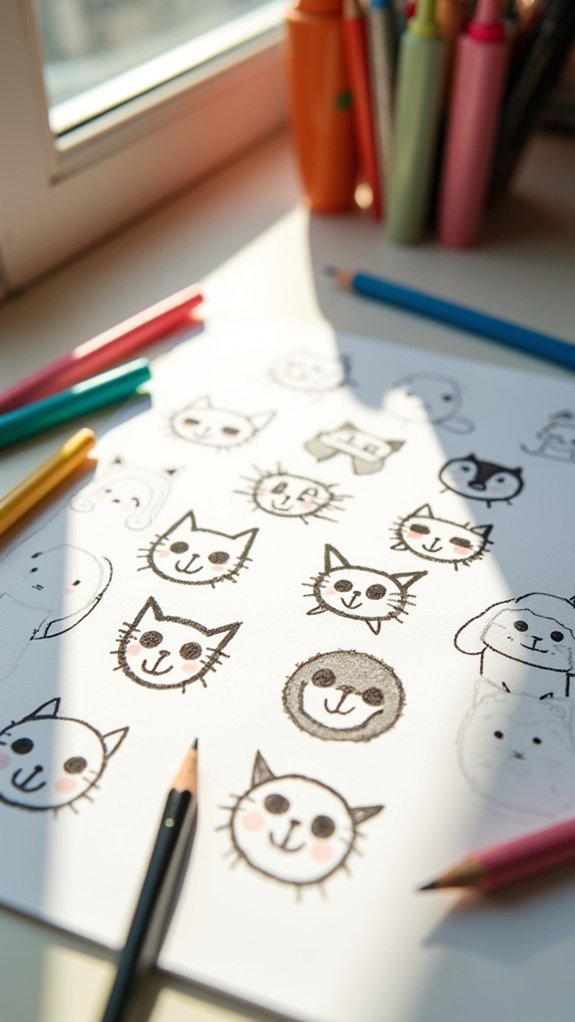
That’s the secret weapon for anyone who wants to draw adorable animal faces. Just start with a circle as the head—it doesn’t have to be a perfect one!
From there, add some big eyes (think “puppy begging for treats” vibes), a tiny nose, and a mouth. Don’t forget the ears, whether it’s long and floppy for bunnies or pointy for cats and dogs.
Playful animal expressions come alive with just a few curved lines—a raised eyebrow or a super wide grin can turn your doodle from “meh” to “awww!”
Practicing different faces helps sharpen your skills. Soon your notebook will be exploding with bunnies, cats, and puppies! Making animals look silly, happy, or surprised is totally part of the fun.
Moon and Night Sky Doodles
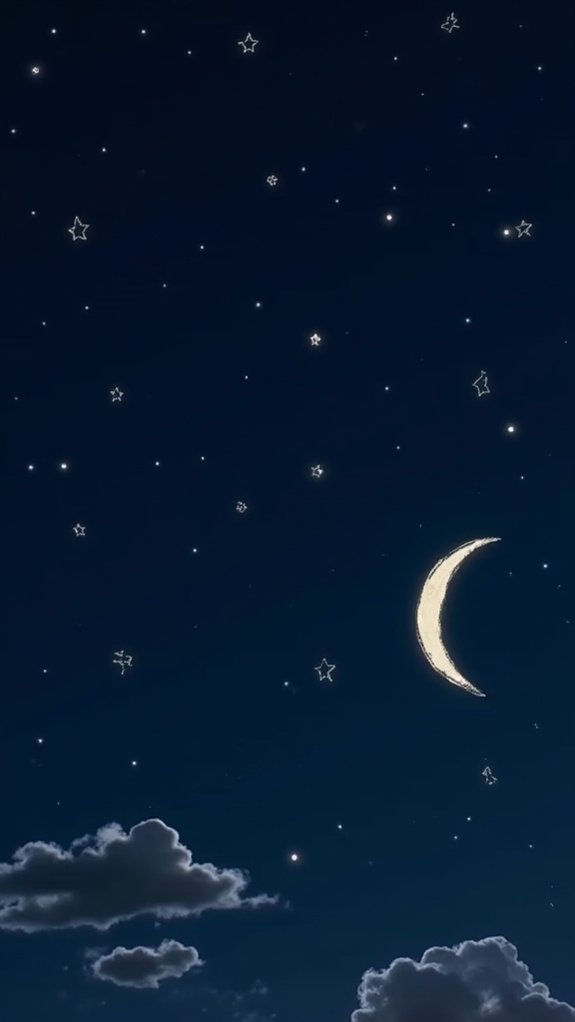
Drawing a moonlit sky doodle starts with something as easy as making a circle for the moon, then tossing in some stars and swirling clouds wherever feels right—no rocket science here!
Mixing up full moons, crescents, and adding a galaxy of wobbly dots or five-pointed stars can make your scene feel like magic waiting to happen.
For extra fun, experiment with dreamy waves or shooting stars, and soon your notebook might look like the cover art for your own science fiction novel.
Drawing Simple Moon Shapes
Moons are basically the night sky’s superstar—mysterious, magical, and, let’s be honest, way easier to draw than you’d think.
Just starting out? Play around with classic moon shapes. All you need is a pencil and a circle. Want a full moon? Draw a big round ball. Feeling half-moon vibes? Shade in half of your circle or add a line down the middle.
For that cool crescent look, overlap two circles and erase what you don’t need. The moon isn’t just a rock—it’s a whole mood! Try adding a funny face or even the “man in the moon” for personality.
And remember, moon shapes can peek out from behind clouds or grin right back at you!
- Full moon (just a circle)
- Crescent moon (overlapping circles)
- Half moon (split and shade)
- Smiling “man in the moon”
Adding Stars and Clouds
Every awesome night sky doodle needs a sprinkle of stars and a few dreamy clouds to really come alive.
For stars, just start by drawing a simple “X” and then add two diagonal lines across each point—boom, instant five-pointed magic! Mixing up the sizes and spacing? That’s where the real fun starts. By adding little and big stars, the sky looks packed with sparkle.
Clouds are easy too—just doodle a bunch of overlapping arcs and circles to make them look extra fluffy and soft. Want more personality? Drop in a classic crescent moon—sketch a circle, then carve out a chunk with an arc.
And don’t forget! A dark blue or purple background really makes those stars and clouds pop.
Creating Dreamy Night Scenes
One of the coolest ways to make a doodle feel magical is to plunge into the world of dreamy night scenes—especially with the moon taking center stage.
Making little doodles of the night sky is easier than it looks and super satisfying! Start with a simple circle for the moon, but mix things up by trying out a crescent or half-moon shape.
Draw fluffy clouds floating around by looping some curved lines—make them as poofy or wispy as you want. Add pops of sparkle with a scatter of tiny stars—some classic five-pointed ones, some just quick little circles.
Next, sketch wavy lines behind everything to create a sense of depth—throw in some silhouettes for extra drama.
- Moon in different phases
- Fluffy clouds
- Pops of scattered stars
- Silhouetted trees or mountains
Sweet Treats and Dessert Doodles
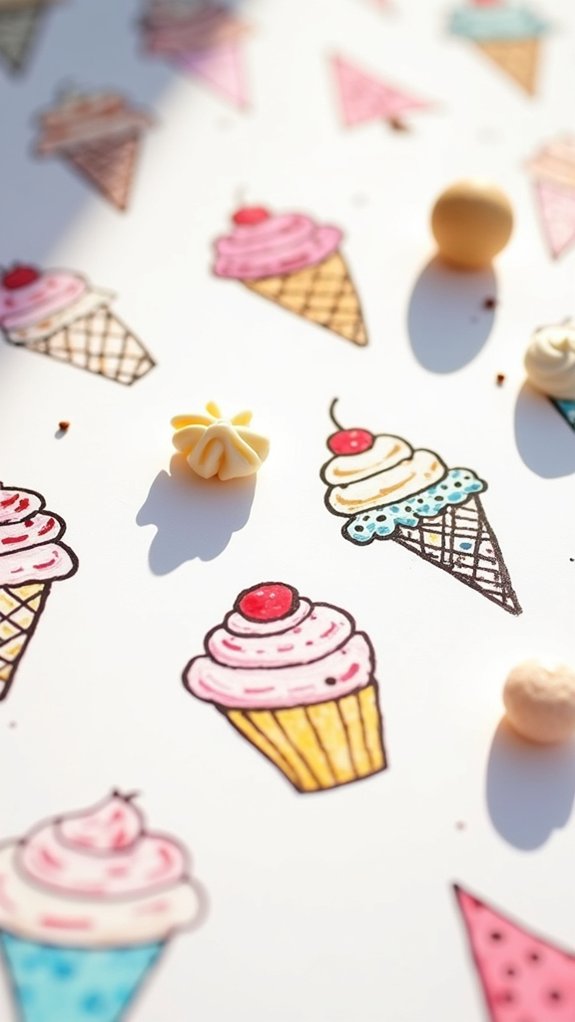
Dessert doodles are totally irresistible—just like the real thing, but without all the crumbs and sticky fingers.
Drawing sweet treats is a blast, with easy favorites like ice cream cones, cupcakes, donuts loaded with rainbow sprinkles, or a perfect slice of cake. Most drawing tutorials for dessert doodles start with super simple shapes—think circles for donuts and triangles for cake slices.
Not only does this make the process foolproof, it lets anyone jump in and create something adorable fast. Add a pop of color, some whipped cream, or even a cherry on top, and suddenly your doodle is alive with fun details.
Want extra flair? Go wild with cute faces or themed backgrounds. Sweet treats are meant to be playful—so let your imagination take the lead!
Observational Details From Your Surroundings
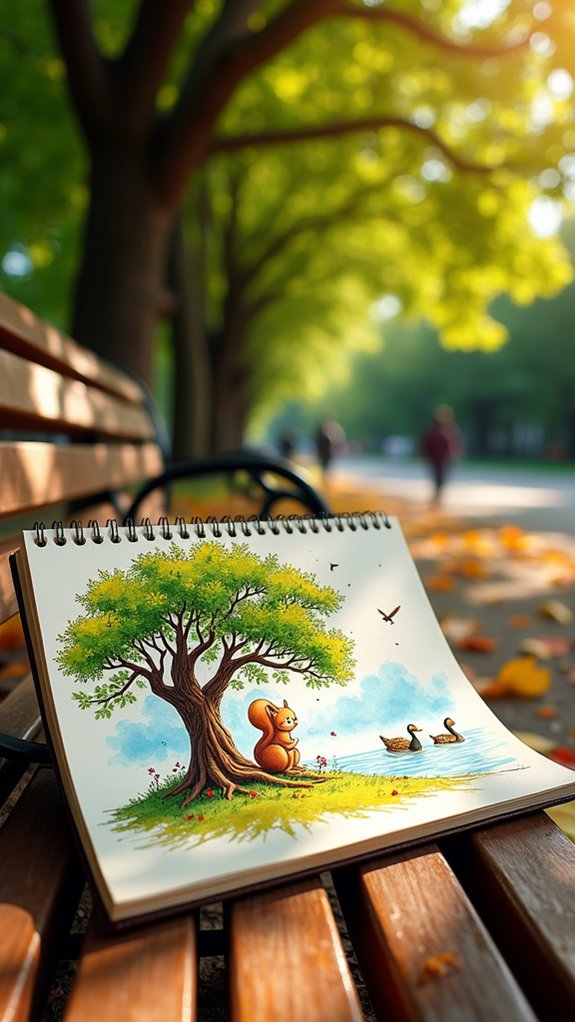
A sketchbook can turn into a treasure map when someone starts doodling the things around them. Look around—there’s a little bit of magic in everyday objects just waiting to be captured with a pencil.
Observational doodling isn’t about creating perfect masterpieces; it’s about grabbing ideas from life and having fun. Maybe it’s your chipped coffee mug, a pile of books, or the plant staring back from your shelf.
Starting with simple shapes makes it all less intimidating. Every little bit you add—like a handle or a streak in a leaf—helps you see more, practice more, and notice tiny details you might normally miss.
- Draw your favorite mug with a circle and handle
- Sketch the spiky leaves of your desk plant
- Turn stacked books into rectangles
- Doodle forks and spoons with lines and ovals
Nested Random Shapes for Patterns
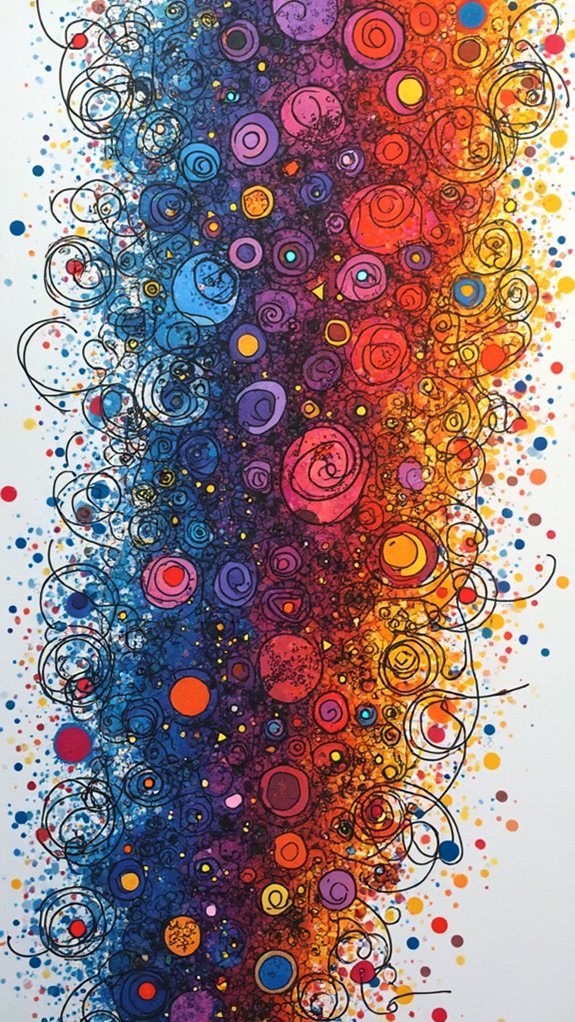
All that looking at mugs and desk plants can get pretty wild, but what happens when there’s nothing nearby to doodle? That’s when nested random shapes step in to save the page from boredom. Drawing one shape inside another—think circles snuggled in circles, or triangles nested in squares—can fill your notebook with mesmerizing patterns. There’s no pressure to be perfect; just start in the center, layer shapes, change sizes, even spin them in wild directions! Add stripes or dots inside some shapes, leave others blank, mix it up.
Here’s a quick guide:
| Shape Used | Pattern Inside |
|---|---|
| Circle | Polka Dots |
| Square | Stripes |
| Triangle | Zigzags |
| Mixed Shapes | Swirls or Blank |
Experiment, combine shapes, and let the randomness lead the way!
Playful Texture Doodles
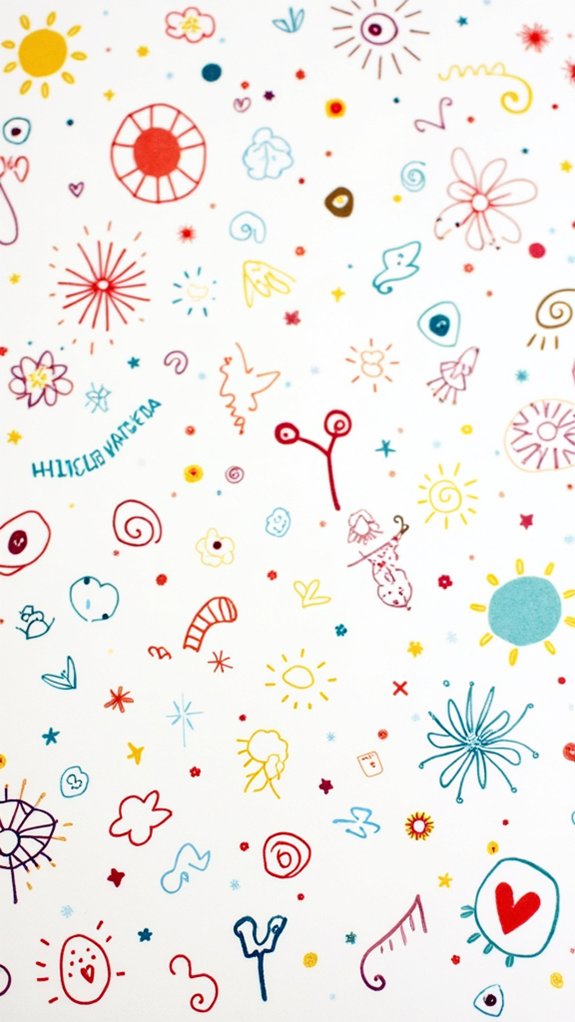
Texture—the secret ingredient in a doodler’s recipe for awesome art. Playful texture doodles aren’t just fun to look at—they make any blank paper come alive!
Want stripes, polka dots, or even a wild cross-hatch? Toss them into your sketches for instant personality. When artists experiment with different textures, like fur or wood grain, their drawings start to jump off the page.
Adding contrasts—smooth next to rough, thin lines next to thick—keeps things interesting and unpredictable, kind of like your favorite plot twist. Repeating shapes improves hand coordination, and who knows, maybe you’ll invent a signature style.
Changing up line thickness or spacing is pretty simple, but the results? Totally epic.
- Stripes in wild directions
- Cheery polka dots
- Cross-hatching for shadow
- Wavy, fabric-like patterns
Frequently Asked Questions
What Are the Best Pens or Pencils for Doodling?
Selecting the best pens or pencils for doodling depends on personal preference and specific Doodle Techniques used. Fineliners, gel pens, and mechanical pencils offer precision and smooth flow, while brush pens provide expressive strokes for varied creative effects.
How Do I Overcome Creative Block When Doodling?
When facing creative block while doodling, individuals often benefit from using Doodle Prompts to spark inspiration. Exploring random shapes, themes, or guided lists can help shift focus, encouraging experimentation and the flow of new ideas.
Can Easy Doodle Drawings Improve My Focus or Reduce Stress?
Research suggests that Mindful Doodling can help improve focus and reduce stress by encouraging relaxation and gentle concentration. This simple creative activity allows individuals to redirect anxious thoughts and enhance mindfulness, benefiting overall mental well-being.
How Long Should I Spend on a Single Doodle?
When considering Doodle Duration, individuals may benefit from spending five to fifteen minutes on a single doodle. This time frame encourages creativity while maintaining relaxation and focus, though personal preference should ultimately guide the ideal Doodle Duration.
Are There Recommended Sketchbooks for Beginners?
The current question addresses whether there are recommended sketchbooks for beginners. Common sketchbook types for novices include spiral-bound, hardbound, and mixed-media options. These provide suitable paper quality, durability, and flexibility, accommodating learning artists’ evolving preferences and techniques.
Conclusion
So, whether someone’s doodling spirals during math class or drawing a goofy sun face on sticky notes, these easy doodles are like tiny escapes for your brain. They’re not about being perfect—mistakes are half the fun! Anyone can pick up a pen and start creating cool shapes and patterns. Seriously, who knew “messing around” could look this awesome? With just a few simple ideas, doodling isn’t just easy—it’s a blast. Keep drawing and see what happens!

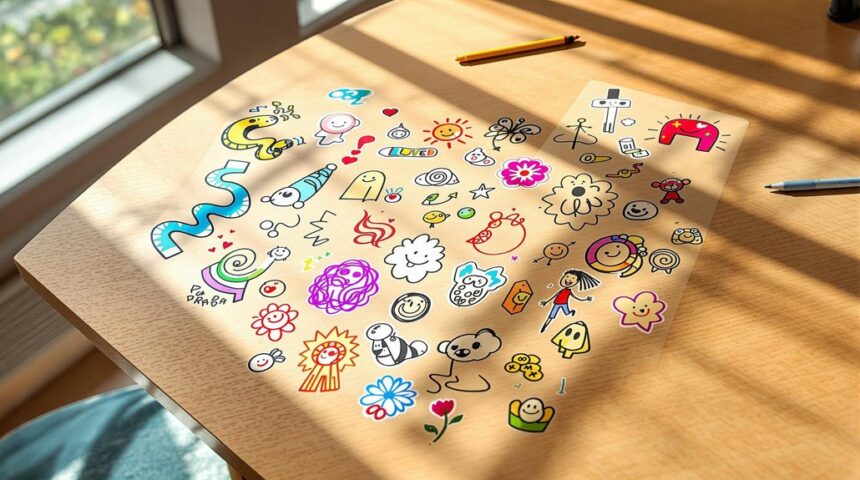
Leave a Reply